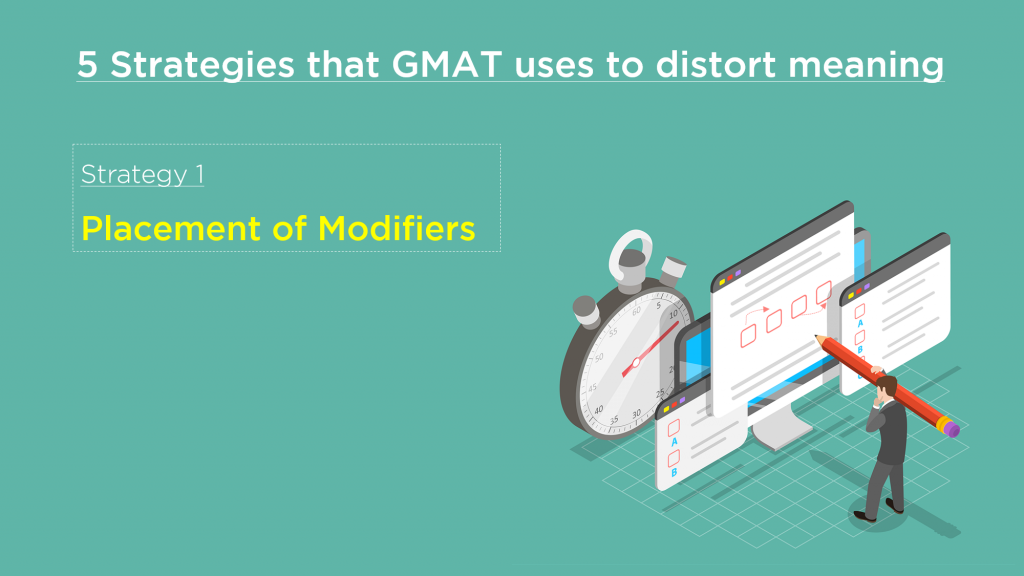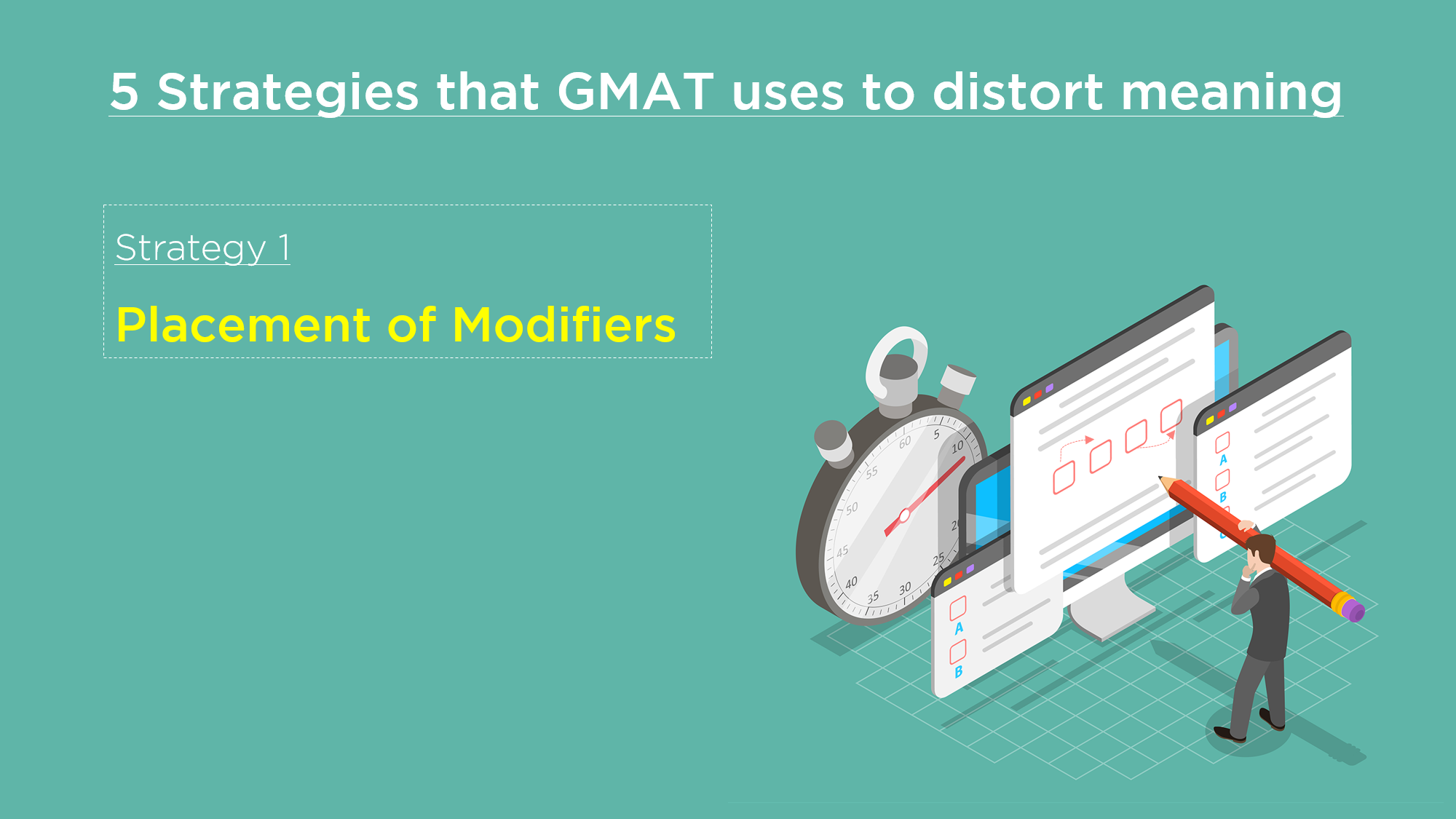A lot of you are re-taking the GMAT in December and have somewhat limited experience on how to deal with the “recent” meaning based SC questions in which the answer choices may contain more than one grammatically correct answer choice. In this case, the student is often confused as to how to select the correct answer choice. This post is designed to address the same. This topic is a series of 5 articles which will cover these strategies and supporting questions with detailed explanation and solutions. Read through the post to understand:
- How does GMAT change the intended logical meaning of the sentence in a “grammatically correct” answer choice?
- The first strategy – “Placement of Modifiers”
- A process to approach SC questions to answer such questions successfully
- Official examples and exercise questions for practice

GMAT Sentence Correction questions test the test taker on how effectively he/she can express the idea or relationship using correct expression conforming to the rules of standard written English. Many times an answer choice may be grammatically correct but may not be the correct choice because it distorts the intended logical meaning of the original sentence. The table below provides a quick summary of strategies that GMAC deploys to achieve the same.
|
Strategies to Distort Meaning |
Description |
Official Question Reference |
| Change placement of modifiers | By changing the placement of modifier, the modified entity can be changed, thereby causing a shift or distortion in meaning |
|
| Use different modifiers | By changing the type of modifier, meaning of the sentence can be changed. |
|
| Use different conjunctions | By changing the conjunctions in a sentence, meaning can be changed in several ways – independent items may be made dependent or vice versa. |
|
| Change Voice of the sentence | By changing the voice of the sentence, the focus of sentence can be shifted enough to cause a shift in the meaning of the sentence |
|
| Remove/add words that provide context or use word differently. |
|
|
Here’s the list of the articles in the complete series:
- 5 Strategies that GMAT uses to distort meaning – Part 1 – Modifiers (Update 2018)
- GMAT and Meaning – Part 2: Strategy 2 – Use of Modifiers
- GMAT and Meaning – Part 3: Strategy 3 – Change of Conjunctions
- GMAT and Meaning – Part 4: Strategy 4 – Change of Voice
- GMAT and Meaning – Part 5 – Change/Remove Words that provide Context
Strategy 1 – Change Placement of Modifiers
How does GMAC use this strategy: Modifiers provide additional or descriptive information about another entity in the sentence. So if these modifiers are placed at different locations in the sentence, the meaning of the sentence changes. This is how GMAC may introduce such meaning based errors. In these cases, both the placements result in logical meaning but only one is correct and that is determined by what the intended meaning of the sentence is.
Let’s take a simple example below:
Simple example

So here is the scene that I picture. Cat is running after the rat. Cat has black stripes. Now let’s check this sentence below.

Now the scene that I picture is – cat is running after the rat. The rat has black stripes. So per this sentence, I no longer have any information about the stripes on the cat. But I have information about the stripes on the rat.
So simply by placing “with black stripes” differently, the meaning communicated by the sentence changes.
This is exactly how GMAT may introduce a difference in meaning.
Official Question 1 – Verbal Review 2 – Q#37
Now let’s take an official question:
Some buildings that were destroyed and heavily damaged in the earthquake last year were constructed in violation of the city’s building code.
- Some buildings that were destroyed and heavily damaged in the earthquake last year were
- Some buildings that were destroyed or heavily damaged in the earthquake last year had been
- Some buildings that the earthquake destroyed and heavily damaged last year have been
- Last year the earthquake destroyed or heavily damaged some buildings that have been
- Last year some of the buildings that were destroyed or heavily damaged in the earthquake had been
Intended meaning from Choice A: The intended meaning of the sentence from choice A can be inferred as follows:
- Some buildings had been destroyed in the earthquake last year.
- (Prior to the destruction) These buildings were constructed in violation of the city’s building code

Note that this sentence has two verbs and based on where “last year” is placed, it can modify either of the two verbs.
Notice that choice A is incorrect since it uses the simple past – were constructed. The correct verb should be “had been constructed” to illustrate correct sequencing with respect to “were destroyed” to show that the buildings were constructed prior to the destruction.
Correct: Choice B corrects this error and is the correct choice.
Grammatically Correct but Incorrect choice (E) – Notice how in choice E the test takers have cleverly moved “last year” in the clause that with SV pair – “some of the buildings had been constructed” such that it now describes when some of these buildings were constructed. It no longer describes the timing of the earthquakes.

The intended meaning communicated by Choice E is the following:
- Some of the buildings had been constructed in violation of city’s building code last year.
- These buildings were destroyed in the earthquake.
Note that in choice E, we now know that the buildings were constructed last year. This is the information that we did not have in choice A. Thus, the meaning communicated by this choice is certainly different from the meaning communicated by choice A. Hence, while choice E is grammatically correct, it changes the logical intended meaning and is not the correct choice.
PS: Access our free concepts on sentence structure if you want to know how to break a compound sentence into simple sentences. Just register at e-gmat.com
Official Question 2 – OG 12 – Q#112
Now let’s take another official question. This time from OG 12.
Gall’s hypothesis of there being different mental functions localized in different parts of the brain is widely accepted today.
- of there being different mental functions localized in different parts of the brain is widely accepted today
- of different mental functions that are localized in different parts of the brain is widely accepted today
- that different mental functions are localized in different parts of the brain is widely accepted today
- which is that there are different mental functions localized in different parts of the brain is widely accepted today
- which is widely accepted today is that there are different mental functions localized in different parts of the brain
Intended meaning from Choice A: The sentence is written in an awkward manner but we can certainly infer the intended meaning.
– A specific hypothesis of Gall is widely accepted today.
– What is the hypothesis? Per this hypothesis – different mental functions are localized in different parts of the brain.
Notice how we know precisely what the hypothesis is.
Error in the original choice: Choice A is not the correct choice since it is not written in a concise manner. The expression “of there being” is very wordy.
Choice C corrects this error and is the correct choice.

Grammatically Correct but Incorrect choice B: Notice how the test makers have moved the descriptive “that” modifier here. Also, the information presented by “that modifier” has also been changed to make logical sense in the changed context. The change in meaning in choice B happens because of placement and wording of “that” modifier. Instead of now stating the hypothesis, now “that” modifier talks about the mental functions. The meaning communicated by choice B is as follows:
- Gall has a certain hypothesis about different mental functions.
- This hypothesis is widely accepted today.
- These different mental functions are localized in different parts of the brain
- Notice carefully that per this choice we do not know precisely what the hypothesis is. All we know is that some hypothesis of different mental functions is widely accepted and we know where the different mental functions are located.

How to evaluate choices that change the meaning?
- Understand the logical meaning of the original choice. (note placement of modifiers)
- Look for the answer choice that best communicates the same meaning in un-ambiguous and grammatically correct manner.
- Ignore choices that may be grammatically correct but change the meaning.
Exercise Sentences
Example 1 – Heartless Human Beings
Heartless human beings are like wild animals, which will rip its own kin at the slightest of need and that too without a sign of remorse.
- Heartless human beings are like wild animals, which will rip its own kin at the slightest of need
- Heartless human beings were like wild animals, which have ripped their own kin at the slightest of need
- Human beings are like heartless wild animals, which rip their own kin in the slightest of need
- Human beings are like heartless wild animals, which rip at its own kin in the slightest of need
- Heartless human beings are like wild animals, which rip their own kin in the slightest of need.
Understand the Meaning of the Original Sentence
The sentence presents a similarity (use of word like) between heartless human beings and wild animals. Heartless human beings are like wild animals. These wild animals rip their own kin when the need arises and they do not even feel any sign of remorse.
Find the Errors in the Original Sentence
- Heartless human beings are like wild animals,
- which will rip its own kin at the slightest of need and that too without a sign of remorse.
The sentence structure of the sentence is as shown above. The two SV pairs agree in number and logically make sense. The simple present tense “are” is appropriate as this sentence states a fact that is true in the present context. However, use of future tense “will rip” appears incorrect. This is a general fact about the wild animals and hence should be stated in simple present tense. Furthermore, “its” pronoun refers to wild animals but it does not agree in number. It should be “their”.
Review Answer Choices to do POE
Choice B – use of past tense “were” implies that heartless humans beings are no longer like wild animals. This distorts the intended meaning. Furthermore, “have ripped” is incorrect since it now no longer communicates a general fact about wild animals. It states as if the action of “have ripped” is a one-time action that has been completed.
Choice C – This choice changes the intended meaning of the sentence. It now implies that “human beings” in general are like “heartless wild animals”. Note that the original sentence implied that “heartless human beings” are like “wild animals”. Thus, by changing the placement of the modifier “heartless”, the meaning of the sentence has changed. Note that this sentence is otherwise grammatically sound.
Choice D – This choice changes the intended meaning of the sentence as choice C does. It also has pronoun error as choice A does. Also, the expression “rip at its own kin” distorts the meaning of the expression “rip its own kin”.
Choice E – Correct Choice.
Takeaways
- Understand the intended meaning of the sentence and then select the choice that correctly communicates that meaning. Understand the role of each modifier in the sentence and note for any changes in the placement of these modifiers.
- Use appropriate verb tense to communicate the intended logical meaning. This implies that you should understand two things
- The function of each verb tense – grammatical knowledge
- The intent of the sentence – What does the sentence want to communicate? – meaning
Example 2 – Mrs Merckel
At the heart of the euro crisis is Mrs. Merckel’s lack of quick or bold reaction, the reason for lack of halting of the downward spiral of the euro.
- Mrs. Merckel’s lack of quick or bold reaction, the reason for lack of halting of the downward spiral of the euro
- Mrs. Merckel, whose lack of quick or bold reaction is the reason that the downward spiral on the euro has not halted
- the lack of quick or bold reaction by Mrs. Merckel, the reason that the downward spiral on the euro has not halted.
- Mrs. Merckel, whose lack of quick or bold reaction is the reason of lack of halting of the downward spiral of the euro.
- the lack of quick or bold reaction by Mrs. Merckel, resulting in the downward spiral of the euro.
Understand the Meaning of the Original Sentence
The sentence presents a few facts
- Mrs. Merckel’s lack of quick or bold reaction is at the heart of euro crisis.
- Her lack of bold reaction is the reason for lack of halting of the downward spiral of the Euro
- This is a rather confusing expression. It intends to say that her lack of bold reaction is the reason why the downward spiral of Euro has not halted or stopped.
Find the Errors in the Original Sentence
- At the heart of euro crisis is Mrs. Merckel’s lack of quick or bold reaction, the reason for lack of halting of the downward spiral of the euro.
This sentence has only 1 clause with inverted SV order. Grammatically this sentence appears to be fine but it is not written in a concise manner. The expression – “lack of halting of …” is overly complicated and confusing.
Review Answer choices to do POE
Choice B – This choice changes the meaning of the sentence. It now states that Mrs. Merckel is at the heart of Euro crisis. Per the original sentence, her lack of quick or bold decision is at the heart of Euro crisis.
Choice C – Correct Choice.
Choice D – This choice repeats the errors of Choice B
Choice E – This choice is grammatically correct. But it changes the intended meaning of the sentence. Now it implies that lack of bold reaction is the reason behind the downward spiral of the Euro. This is not correct. Note that per the intended meaning – downward spiral of Euro is already happening. Mrs. Merckel is not taking a quick or bold decision. This indecisiveness results in continuation of the downward spiral. Thus, it’s not like this indecisiveness results in the downward spiral of Euro. It results in not being able to stop this downward spiral.
Takeaways
- Understand the intended meaning of the sentence and then select the choice that correctly communicates that meaning. Understand the role of each modifier in the sentence and note for any changes in the placement of these modifiers.
Here’s a list of the articles in the complete series:
- 5 Strategies that GMAT uses to distort meaning – Part 1 – Modifiers (Update 2018)
- GMAT and Meaning – Part 2: Strategy 2 – Use of Modifiers
- GMAT and Meaning – Part 3: Strategy 3 – Change of Conjunctions
- GMAT and Meaning – Part 4: Strategy 4 – Change of Voice
- GMAT and Meaning – Part 5 – Change/Remove Words that provide Context
If you are planning to take the GMAT, we can help you with a personalized study plan and give you access to quality online content to prepare. Write to us at acethegmat@e-gmat.com. We are the most reviewed GMAT prep company on gmatclub with more than 2400 reviews and are the only prep company that has delivered more than 700+ scores than any other GMAT club partner. Why don’t you take a free trial and judge for yourself?













